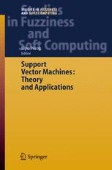Search
Search Results
-
Componentwise Least Squares Support Vector Machines
This chapter describes componentwise Least Squares Support Vector Machines (LS-SVMs) for the estimation of additive models consisting of a sum of...
-
Fuzzy Support Vector Machines with Automatic Membership Setting
Support vector machines like other classification approaches aim to learn the decision surface from the input points for classification problems or...
-
Adaptive Discriminant and Quasiconformal Kernel Nearest Neighbor Classification
Nearest neighbor classification assumes locally constant class conditional probabilities. This assumption becomes invalid in high dimensions due to...
-
Some Considerations in Multi-Source Data Fusion
We introduce the data fusion problem and carefully distinguish it from a number of closely problems. Some of the considerations and knowledge that...
-
Fuzzy Process Control with Intelligent Data Mining
The quality-related characteristics cannot sometimes be represented in numerical form, such as characteristics for appearance, softness, color, etc....
-
Evolutionary Induction of Descriptive Rules in a Market Problem
Nowadays, face to face contact with the client continues to be fundamental to the development of marketing acts. Trade fairs are, in this sense, a...
-
Clustering with Intelligent Techniques
Cluster analysis is a technique for grou** data and finding structures in data. The most common application of clustering methods is to partition a...
-
Self-Tuning Fuzzy Rule Bases with Belief Structure
A fuzzy rule-based evidential reasoning (FURBER) approach has been proposed recently, where a fuzzy rule-base designed on the basis of a belief...
-
Personalized Multi-Stage Decision Support in Reverse Logistics Management
Reverse logistics has gained increasing importance as a profitable and sustainable business strategy. As a reverse logistics chain has strong...
-
Advanced Simulator Data Mining for Operators’ Performance Assessment
This chapter covers the use of data mining operations associated with power plant simulations for training and other purposes, such as risk...
-
Data Mining for Maximal Frequent Patterns in Sequence Groups
In this paper, we give a general treatment for mining some kinds of sequences such as customer sequences, document sequences, and DNA sequences....
-
Sensory Quality Management and Assessment: from Manufacturers to Consumers
This paper presents an intelligent technique based method for analyzing and interpreting sensory data provided by multiple panels for the evaluation...
-
Evidence Based Telemedicine
This chapter focuses on evidence based telemedicine and its various applications. Evidence based medicine is the integration of best research...
-
Virtual Communities in Health Care
A virtual community is a social entity involving several individuals who relate to one another by the use of a specific communication technology that...
-
Active-Set Methods for Support Vector Machines
This chapter describes an active-set algorithm for quadratic programming problems that arise from the computation of support vector machines (SVMs)....
-
Local Learning vs. Global Learning: An Introduction to Maxi-Min Margin Machine
We present a unifying theory of the Maxi-Min Margin Machine (M4) that subsumes the Support Vector Machine (SVM), the Minimax Probability Machine...
-
Application of Support Vector Machine to the Detection of Delayed Gastric Emptying from Electrogastrograms
The radioscintigraphy is currently the gold standard for gastric emptying test, but it involves radiation exposure and considerable expenses. Recent...
-
An Accelerated Robust Support Vector Machine Algorithm
This chapter proposes an accelerated decomposition algorithm for robust support vector machine (SVM). Robust SVM aims at solving the overfitting...
-
Unsupervised Learning Neural Networks
This chapter introduces the basic concepts and notation of unsupervised learning neural networks. Unsupervised networks are useful for analyzing data...
-
Evolutionary Computing for Architecture Optimization
This chapter introduces the basic concepts and notation of evolutionary algorithms, which are basic search methodologies that can be used for...
